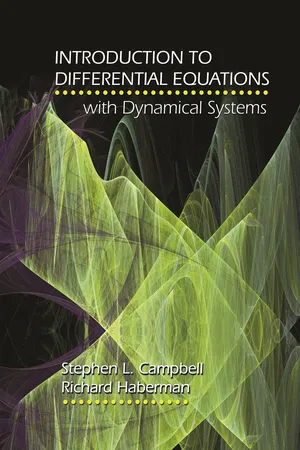Technology & Engineering
Exact Differential Equation
An exact differential equation is a type of differential equation where the total differential of a function can be expressed as a combination of the differentials of its variables. This means that the equation can be solved by finding a function whose total differential matches the given equation. Exact differential equations are important in engineering and physics for modeling various physical phenomena.
Written by Perlego with AI-assistance
Related key terms
Related key terms
1 of 4
Related key terms
1 of 3
3 Key excerpts on "Exact Differential Equation"
- Stephen L. Campbell, Richard Haberman(Authors)
- 2011(Publication Date)
- Princeton University Press(Publisher)
CHAPTER 1
First-Order Differential Equations and Their Applications
1.1 Introduction to Ordinary Differential Equations
Differential equations are found in many areas of mathematics, science, and engineering. Students taking a first course in differential equations have often already seen simple examples in their mathematics, physics, chemistry, or engineering courses. If you have not already seen differential equations, go to the library or Web and glance at some books or journals in your major field. You may be surprised to see the way in which differential equations dominate the study of many aspects of science and engineering.Applied mathematics involves the relationships between mathematics and its applications. Often the type of mathematics that arises in applications is differential equations. Thus, the study of differential equations is an integral part of applied mathematics. Applied mathematics is said to have three fundamental aspects, and this course will involve a balance of the three:- The modeling process by which physical objects and processes are described by physical laws and mathematical formulations. Since so many physical laws involve rates of change (or the derivative), differential equations are often the natural language of science and engineering.
- The analysis of the mathematical problems that are posed. This involves the complete investigation of the differential equation and its solutions, including detailed numerical studies. We will say more about this shortly.
- However, the mathematical solution of the differential equation does not complete the overall process. The interpretation of the solution of the differential equation in the context of the original physical problem must be given, and the implications further analyzed.
Using the qualitative- eBook - ePub
Differential Equations
A Modern Approach with Wavelets
- Steven Krantz(Author)
- 2020(Publication Date)
- Chapman and Hall/CRC(Publisher)
1What Is a Differential Equation?
• The concept of a differential equation • Characteristics of a solution • Finding a solution • Separable equations • First-order linear equations • Exact equations • Orthogonal trajectories1.1 Introductory Remarks
A differential equation is an equation relating some function f to one or more of its derivatives. An example isd 2fdx 2( x )+ 2 xd fd x( x )+f 2( x )= sin x .(1.1.1) Observe that this particular equation involves a function f together with its first and second derivatives. Any given differential equation may or may not involve f or any particular derivative of f. But, for an equation to be a differential equation, at least some derivative of f must appear. The objective in solving an equation like (1.1.1) is to find the function f. Thus we already perceive a fundamental new paradigm: When we solve an algebraic equation, we seek a number or perhaps a collection of numbers; but when we solve a differential equation we seek one or more functions.As a simple example, consider the differential equationy ′= y .It is easy to determine that any function of the form y = Cex is a solution of this equation. For the derivative of the function is equal to itself. So we see that the solution set of this particular differential equation is an infinite family of functions parametrized by a parameter C. This phenomenon is quite typical of what we will see when we solve differential equations in the chapters that follow.Many of the laws of nature—in physics, in engineering, in chemistry, in biology, and in astronomy—find their most natural expression in the language of differential equations. Put in other words, differential equations are the language of nature. Applications of differential equations also abound in mathematics itself, especially in geometry and harmonic analysis and modeling. Differential equations occur in economics and systems science and other fields of mathematical science. - eBook - ePub
Differential Equations
Theory,Technique and Practice with Boundary Value Problems
- Steven G. Krantz(Author)
- 2015(Publication Date)
- Chapman and Hall/CRC(Publisher)
Chapter 1What Is a Differential Equation?
- The concept of a differential equation
- Characteristics of a solution
- Finding a solution
- Separable equations
- First-order linear equations
- Exact equations
- Orthogonal trajectories
1.1 Introductory Remarks
A differential equation is an equation relating some function f to one or more of its derivatives. An example is(1.1.1)d 2fdx 2( x )+ 2 xd fd x( x )+f 2( x ) = sin x .Observe that this particular equation involves a function f together with its first and second derivatives. Any given differential equation may or may not involve f or any particular derivative of f . But, for an equation to be a differential equation, at least some derivative of f must appear. The objective in solving an equation like (3.1.1) is to find the function f . Thus we already perceive a fundamental new paradigm: When we solve an algebraic equation, we seek a number or perhaps a collection of numbers; but when we solve a differential equation we seek one or more functions .As a simple example, consider the differential equationy ′= y .It is easy to determine that any function of the form y =Cexis a solution of this equation, for the derivative of the function is equal to itself. So we see that the solution set of this particular differential equation is an infinite family of functions parametrized by a parameter C . This phenomenon is quite typical of what we will see when we solve differential equations in the chapters that follow.Many of the laws of nature—in physics, in engineering, in chemistry, in biology, and in astronomy—find their most natural expression in the language of differential equations. Put in other words, differential equations are the language of nature. Applications of differential equations also abound in mathematics itself, especially in geometry and harmonic analysis and modeling. Differential equations occur in economics and systems science and other fields of mathematical science.
Index pages curate the most relevant extracts from our library of academic textbooks. They’ve been created using an in-house natural language model (NLM), each adding context and meaning to key research topics.
Explore more topic indexes
Explore more topic indexes
1 of 6
Explore more topic indexes
1 of 4


